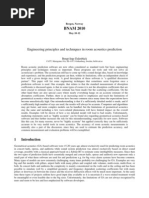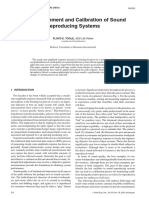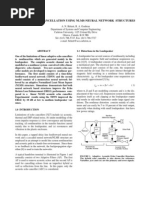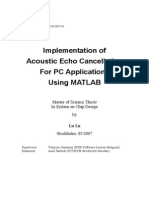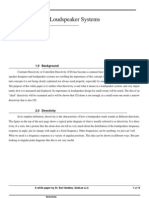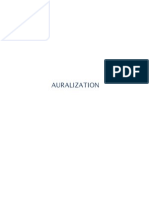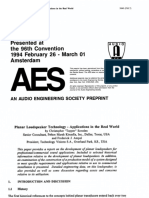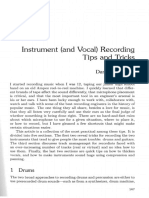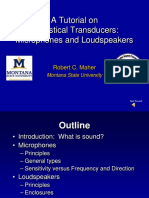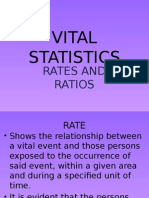Implementing Loudness Models in Matlab
Uploaded by
Pro AcousticImplementing Loudness Models in Matlab
Uploaded by
Pro AcousticProc. of the 7th Int.
Conference on Digital Audio Effects (DAFX-04), Naples, Italy, October 5-8, 2004
DAFX-1
IMPLEMENTING LOUDNESS MODELS IN MATLAB
J. Timoney, T. Lysaght Marc Schoenwiesner L. McManus
Dept. of Computer Science Dept. of Zoology Dept. of Elec. Engineering
NUI Maynooth, Maynooth, Co.
Kildare, Ireland
University of Leipzig, Leipzig,
Germany
DIT, Dublin, Ireland
Jtimoney,tlysaght@cs.may.ie marcs@rz.uni-leipzig.de Lorcan.mcmanus@dit.ie
ABSTRACT
In the field of psychoacoustic analysis the goal is to construct a
transformation that will map a time waveform into a domain that
best captures the response of a human perceiving sound. A key
element of such transformations is the mapping between the sound
intensity in decibels and its actual perceived loudness. A number of
different loudness models exist to achieve this mapping. This paper
examines implementation strategies for some of the more well -
known models in the Matlab software environment.
1. INTRODUCTION
The primary tool in the field of audio for the time -
frequency analysis of sound is the Spectrogram. It is popular because
it is computationally fast and its output is well understood. However,
since the 1990s much work has been carried out on the development
of better tools for sound analysis that make more efforts to take into
consideration its psychoacoustic properties. This has been driven by
the availability of the technology to fully implement the results of
psychoacoustic research that had been published over the decades
previously combined with the desire for significant advances in the
coding of speech and audio signals, the MP3 standard being a good
example. Thus nowadays, many algorithms designed for speech and
audio processing will m ake reference to pyschoacoustic
transformations. An important limitation of the spectrogram in this
regard is manner in which the signal intensity is displayed, generally
in Decibels SPL. While this provides a measure of objective sound
intensity, it does not properly capture the subjective impression a
sound creates on the listener in terms of its loudness. To achieve this
the sensitivity of the ear to the various sound levels of the frequency
components contained in the sound must be accounted for. This is
the kind of information contained in equal loudness curves for the
human ear [1]. These curves show that the ear is less sensitive to low
frequency sounds, having a maximum sensitivity in the region of 3-
4kHz. Employing these curves to modify the dB SPL intensity
display of the sound transforms the intensity to the Phon scale,
where different frequency components having the same Phon value
will have the same loudness but will have different dB SPL
intensities. One disadvantage with the Phon scale is that it is not
directly proportional to perceived loudness, and thus a doubling of
loudness value in Phons does not mean a doubling of the sound
loudness [2]. To this end, the Sone scale was introduced to provide a
linear scale of loudness. The Sone scale can be related to the phon
scale by the equation [3]
( )
( )
( )
( )
( ) ( )
( ) 40 , 2
40 ,
40
40 1 . 0
642 . 2
<
,
_
i D if i L
i D if
i D
i L
i D
(1)
where ( ) i L is the perceived loudness of the critical band i, and
( ) i D is the spread critical spectrum in terms of phons in band i. The
conversion from a time domain signal to a representation that
describes its loudness in terms of Sone is outlined in Figure 1
Figure 1: Block Diagram of loudness modeling procedure [4]
There are various approaches to implementing the different stages of
the Loudness model in Figure 1. The basic procedure is to first
transform the signal into the time-frequency domain. The frequency
analysis points specified will have a relation to the critical band
resolution of the ear. Time and Frequency masking may be
accounted for and compensation carried out for components below
the threshold of audibility. This stage is followed by a conversion
from the intensity levels of each time-frequency slice to specific
loudness levels for each frequency band that are then summed to
give the overall loudness for each time slice.
In this paper, three implementation strategies are examined:
1. A direct implementation based on a time -frequency
decomposition, a mapping from dB SPL to Phon followed
by a direct implementation of equation (1).
2. Three implementations of Zwickers model.
3. The Moore and Glasberg Loudness model
Speech waveform
Specific
Loudness
Total Loudness
Time-Frequency
Decomposition
and
Ear Response Compensation
Proc. of the 7th Int. Conference on Digital Audio Effects (DAFX-04), Naples, Italy, October 5-8, 2004
DAFX-2
The sources for some of the implementations discussed are speech
quality measurement strategies. Specifically, the time -frequency
decompositions and loudness conversion from the EMBSD [3],
PSQM [10] and PEAQ [12] measures are investigated.
2. MODEL IMPLEMETATIONS
2.1 Calibration
In all implementations the first, and possibly most crucial,
stage is the calibration of the input signal. In Matlab sounds typically
are read in from wav files normalize the amplitude levels of the
sound to lie between 1 and 1. However, this will neither reflect the
true recording or playback levels of the sound. The ampl itude of
sound can be scaled to give the sound a desired value of dB SPL.
When using dB SPL to set s sound level, a value for the reference
level must be chosen. For air, the reference level is usually chosen as
20 micropascals [5]. If the actual dB SPL used when recording the
sound is unknown, in the case of speech, if it is at a normal level, it is
reasonable to assume a conversational level of between 65 and 70
dB SPL. Thus, to scale the signal vector y to a level of 70dB in
Matlab [6],
SPLmeas=70;
Pref = 20e-6;
y_refscaled= (y./Pref);
RMS=sqrt(mean(y_refscaled.^2));
SPLmat=20*log10(RMS); % dBSPL in matlab
c=10^((SPLmeas-SPLmat)/20);
ycal=c*(y_refscaled);
If the HUTear toolbox is installed, it is also possible to use the
function [7],
ret=Pascalize(y,70);
2.2 Direct Implementation of Loudness Representation
The algorithm for the direct implementation is taken from the
EMBSD speech quality measure. The signal is separated into frames,
each one windowed with a Hanning function and the power spectral
density obtained. Each power spectrum is partitioned into critical
bands of width one bark, with an upper frequency limit of 3.4 kHz.
In [3] Schroeders spreading function model is applied to include the
effects of frequency masking across the critical bands. The loudness
level of each critical band in units of phon is obtained using a set of
equal-loudness contours taken from the literature and dB intensity
values that lie in between the published contours are interpolated to
get the correct loudness level [3]. These loudness levels are then
converted to sone using equation (1).
NFFT=1024;NOVERLAP=0;
Bf=1:18;
[Yxx,f] = psd(ycal,NFFT,fs,NFFT,0);
Yxx_scale=(2.*Yxx)./NFFT;
[B_XX,bark]=bk_frq02(Bf,f,Yxx_scale);
C_XX=spread_new(Bf,B_XX);
P_XX=dbtophon(C_XX);
S_XX=phtosn(P_XX);
N_mbsd(l)=sum(S_XX);
The Matlab programs are as given in [3]. However, it was found that
it was necessary to make adjustments to the program dbtophon.m.
First of all, in the program code a file named equal.mat is called as
it holds the transcribed equal loudness contours. However, the C
program version in the thesis also contains the contour values in an
array, which can be copied for use with Matlab. Furthermore, the
lines below, which were found to cause errors on occasion,
j = 1;
while T(i) >= eqlcon(j,i)
j = j + 1;
if j == 16
fprintf(1,'ERROR\n')
end
end
if j == 1
P_XX(i) = phons(1);
can be replaced with
[I]=find(T(i)<=equalcon(:,i));
if min(I)==1
P_XX(i)=phons(1);
2.3 Implementations based on Zwickers model
Possibly the most well-known and popular model of loudness is the
one proposed by Zwicker. It has formed part of an international
standard [8], and has been adopted as for use in a number of ITU
standards on speech and audio quality. However, differences exist in
the implementations.
2.3.1 Implementation of the DIN 45631/ISO532B Loudness
Model
This Matlab program was a direct conversion from the basic
program provided in [6]. This implementation uses a filterbank of
one-third-octave filters for the spectral decomposition of the signal,
however, a drawback is that this yields only a rough approximation
to the shape of the auditory filters and the location of their center
frequencies. The equation for the specific loudness N in Sone/Bark
of a the dB SPL sound level
G
L
in a one-third-octave band is given
by [9]
( )
1
]
1
,
_
+
1 10
4
1
11 . 10 . 0064 . 0
1 . 0 025 . 0
ETQ o G ETQ
L a L L
N
(2)
The transmission of freefield sound to our hearing system through
the head and the outer ear is described as attenuation
0
a
. The
excitation threshold in quiet is
ETQ
L
. Values for these two
parameters were given in [8]. To run the implementation given in
[6], the sequence of Matlab commands is
[Yxx,f]=PowSpec(Pref.*ycal,fs,df);
[YdB, err]=Convert2dB(Yxx, 1);
In this implementation, the power spectral density of the signal
Yxx is found without the factor Pref taken into account, and
Proc. of the 7th Int. Conference on Digital Audio Effects (DAFX-04), Naples, Italy, October 5-8, 2004
DAFX-3
only when this quantity is converted to dB is it included, i.e. inside
Convert2dB.m
YdB=10*log10((cal^2)*Yxx/(Pref^2));
The other input arguments to PowSpec are fs and df, which are
the sampling frequency and the frequency resolution respectively.
The third-octave-band filters are generated using the code below,
the filter design is by a program obtained from the mathworks
called Oct2dsgn.m. f is an output of PowSpec. Scaling of the
filter responses is carried out to ensure no energy gain in
introduced into the signal. The filtered bands of the signal power
spectrum is given as Lt.
%% Filter
[H, err]=GenerateFilters_16000(f);
H=0.94833723551160*H;
for ink=1:24
Lt(ink)=10*log10(sum((10.^(YdB/10)).*(abs(H(ink,:
).^2))));
end
The final function call returns the total loudness N and specific
loudness vector Ns. The input MS defines the sound field and by
default is set to a free field, i.e., MS = 'f'.
%% Calculate Loudness
[N, Ns, err]=DIN45631_16000(Lt, MS);
2.3.2 Zwickers Loudness model as used in PSQM
The PSQM algorithm was adopted by the ITU for speech quality
assessment [10], but only recently has it been replaced by the PESQ
algorithm [11]. The equation used for the i mplementation of
Zwickers model is different to (2). The specific loudness
( )
n
f LX
is given by
( )
( ) ( )
( )
1
1
]
1
,
_
+
,
_
1 5 . 0 5 . 0
5 . 0
0
0
f P
f PPX f P
S f LX
n
l n
(3)
where
l
S
is a scaling factor,
( ) f P
0
is the absolute hearing threshold
at frequency f and
( )
n
f PPX
is the Pitch Power Density at
frequency f for frame n. is a constant. The Pitch power densities
are the power spectrum of a signal frame warped to the bark scale
with a resolution of 0.321 Bark, with scaling relative to the
bandwidth in Hertz. According to the PSQM document [10],
5 . 240 1
l
S
and 001 . 0 ,
[Yxx,f]=psd(ycal,NFFT,fs,NFFT,NOVERLAP);
deltaz=0.312;
for i=2:57
deltaf=Ffreqs(i)-Ffreqs(i-1);
scal=(deltaf./deltaz);
indice=(Ffreqs(i-1) <= f & f < Ffreqs(i));
index=find(indice>0);
index_first=index(1);
index_last=index(end);
PPX(i-1)=(scal./(index_last-
index_first+1)).*sum(Yxx(Ffreqs(i-1) <= f & f <
Ffreqs(i)));
end
Lx=Sl.*(P0).^gamma.*(((1-
0.5+0.5.*PPX./P0).^gamma)-1);
Lx(find(Lx<0))=0;
N_pseq=sum(Lx);%total loudness
2.3.3 Zwickers Loudness model as used in PEAQ
This is the most sophisticated of the psycho-acoustic decompositions
[12]. The power spectrum of each frame is weighted by the
frequency response of the outer and middle ear derived from a
model. The power spectral energies are then grouped into Critical
bands, spaced at 0.25 Bark. An offset is then added to the Critical
band energies to compensate for internal noise generated in the ear.
A triangular (in dB) spreading function is used to implem ent
spreading in the frequency domain.
SR
E
~
is the spread excitation
pattern. Unlike the PSQM algorithm the values for the excitation
threshold in PEAQ was computed using a model description [12],
with c a constant that is set to 1.07664,
( )
( )
( )
( )
( ) ( )
( ) 1
1
]
1
,
_
,
_
1
~
1
23 . 0 23 . 0
0
f E
f E f s
f s
E f s
f E
c f LX
t
n SR t
n
(4)
where, in terms of dB, the threshold index is given by
( )
,
_
,
_
,
_
2
1 1
1600
tan 75 . 0
4000
tan 05 . 2 2
f f
f s
dB
(5)
the excitation threshold is
( ) ( )
8 . 0
1000 64 . 3
f f E
tdB
(6)
A complete implementation of this function is given in [13]. The
variables X2 are the power spectrum of the frame, Eb is the bark
warped spectrum, E is the spectrum following the application of
spreading, and Lx and Ntot are the specific loudness and total
loudness respectively. The functions named in the code below
are the same as described in [13] but with the additional input
parameters of signal length len and sampling frequency Fs.
X2=PQDFTFrame(ycal,len);
Eb=PQgroupCB(X2,'Basic',len,Fs);
E=PQspreadCB(Eb,'Basic',Fs);
[Ntot,LX]=PQLoud(E,'Basic','FFT',Fs);
N_tot(l)=Ntot;
2.4 Loudness Model of Moore and Glasberg
The model of Moore and Glasberg [14] is different to that of
Zwicker in that the auditory frequency scale used is the
equivalent rectangular bandwidth (ERB) and the equation for the
specific loudness in a filter band is
( )
ThQ sig
E E C N
'
(7)
where
sig
E
is the excitation pattern within a particular frequency
band,
ThQ
E
is the excitation at the hearing threshold, and C and
are constants.
A Matlab implementation was proposed by [15]. It relied on the
HUTear toolbox [7] to calculate the excitation patterns.
Assuming a gammatone filterbank with 128 filters, the suggested
model input parameters were
model.fs=Fs;
[f,b,CentFreq]=Make_cgtbank(128,Fs,200,6);
Proc. of the 7th Int. Conference on Digital Audio Effects (DAFX-04), Naples, Italy, October 5-8, 2004
DAFX-4
save gt128_test f b CentFreq;
model.cochlea.fb.file='gt128_test.mat'; %
model.cochlea.asymmcomp=1;
model.haircell.rcf.r='half';
model.haircell.rcf.c=0.7;
model.haircell.rcf.f='1kHz';
model.neural.function='mean';
For each frame the excitation pattern of the signal was generated
using the AudMod function from the toolbox [7],
Esig=AudMod(frame(:,l),model);
Similarly, to generate the excitation pattern at the hearing
threshold,
[CrctLinPwr, frqNpnts, CrctdB] =
OutMidCrct2('MAF',128,Fs);
MAF =
interp1_ext(frqNpnts,CrctdB,CentFreq,'linear','ex
trap');
for i=1:length(CentFreq)
tones(i,:)=pascalize(sin(2.*pi.*(0:frame_len-
1).*CentFreqs(i)./Fs),MAF(i));
end;
Ethq=AudMod(sum(tones),model);
Once the excitation patterns are known, the specific and total
loudness can be calculated. To find the total loudness from the
specific loudness, scaling is applied based on the bandwidth of the
ERB filters before summing.
N=C.*(Estim.^alpha-Ethq.^alpha);
N(find(N<0))=0;
EarQ = 1/0.107939;
minBW = 24.7;
order = 1;
b = 1.019;
ERBwidth = ((CentFreq/EarQ).^order +
minBW^order).^(1/order);
totalLoudness=sum((N.*ERBwidth)');
3. OUTPUT CALIBRATION AND TESTING
In the cases of the MBSD loudness model, the PSQM loudness
model and the Moore and Glasberg loudness model calibration was
found to be necessary. The Matlab function lsqcurvefit.m from
the optimization toolbox was used. One of its requirements is a
function name within its input arguments, and using the MBSD
loudness model as an example, it was be written in the form
function [l]= mbsd_cal(coef,S_XX)
l=diag(sqrt(coef.*S_XX)*sqrt(coef.*S_XX)');
where coef is the calibration parameter, S_XX is excitation used to
compute the specific loudness and l is the total loudness.
512-point Sinewaves of frequency 1000Hz and sampling frequency
16kHz that were calibrated to be { } 80 , 70 , 60 , 50 , 40 dB SPL that
should have a total loudness of { } 16 , 8 , 4 , 2 , 1 were used. In the case
of the MBSD loudness model S_XX needs to be called by a factor
0.2567. For the PSQM model,
4
10 63 . 7
l
S
and 2941 . 0 .
For the Moore and Glasberg model 0002 . 0 C and 8885 . 0 .
Model 40db 50dB 60dB 70dB 80dB
MBSD 0.701 1.709 3.835 7.97 16.102
DIN45631 0.8030 1.974 4.513 9.43 18.76
PSQM 0.975 1.985 4.001 8.007 15.98
PEAQ 1.312 2.551 4.701 8.363 14.486
MooreGlas 0.9364 2.06 3.978 7.23 13.1
Table 1: Input Sinusoid SPL Values and Models outputs in Sones
The total loudness in Sone produced by each model for these
sinewaves is given in Table 1. It can be seen from the table that
none of the measures produce the exact figure for total loudness
but that all are approximately close to the expected value.
3. CONCLUSIONS
This paper has presented Matlab implementations of a number
of loudness models. Furthermore, where necessary the issue of
model calibration was addressed. Finally, results were presented to
demonstrate the model output for a sinewaves of various dB SPL
levels.
4. REFERENCES
[1] Gelfand, S.A., Hearing: An Introduction to Psychological and
Physiological Acoustics, Marcel Dekker, 1998.
[2] http://hyperphysics.phy-
astr.gsu.edu/hbase/sound/phon.html#c2
[3] Wonho, Y., Enhanced modified bark spectral distortion
(EMBSD):An objective speech quality measure based on
audible distortion and cognition model, Ph.D. thesis, Temple
University, Ft. Washington, USA, 1999.
http://www.temple.edu/speech_lab/Wonhos_Dissertation.PDF
[4] Appell, J., et al., Review of loudness models for normal and
hearing-impaired listeners based on the model proposed by
Zwicker, Audiologische Akustik, 40, No.(2), 2002.
[5] http://www.nd.edu/~atassi/Teaching/ame553/Notes/Sound_po
wer.pdf
[6] http://widget.ecn.purdue.edu/~hastinga/Research.htm
[7] http://www.acoustics.hut.fi/software/HUTear/
[8] Zwicker, E., Fastl, H., and Dallmayr, C., BASIC program for
calculating the loudness of sounds from their 1/3 oct band
spectra according to ISO 532 B, Acustica 55, 1984, pp. 63-67.
[9] Quast, H., Absolute Perceived Loudness of Speech,
Proceedings of the 7th Joint Symposium on Neural
Computation, USC, 2000.
[10] ITU Recommendation, P.861 Objective Measurement of
Telephone Band (300-3400Hz) Speech Codecs (PSQM)
[11] ITU Recommendation, P.862 Perceptual Evaluation of Speech
Quality (PESQ), the New ITU Standard for End-to-end Speech
Quality Assessment,
[12] Thiede, T., Perceptual Audio Quality Assessment using a Non-
Linear Filter Bank, Ph.D. thesis, Technische Universitat Berlin,
Berlin, Germany, 1999.
[13] Kabal, P., An Examination and Interpretation of ITU -R
BS.1387: Perceptual Evaluation of Audio Quality, TSP Lab
Proc. of the 7th Int. Conference on Digital Audio Effects (DAFX-04), Naples, Italy, October 5-8, 2004
DAFX-5
Technical Report, Dept. Electrical & Computer Engineering,
McGill University, May 2002.
http://www.tsp.ece.mcgill.ca/MMSP/Documents/Reports/index
.html#KabalR2002
[14] Moore, B., Glasberg, B., Baer, T., A model for the prediction
of thresholds, loudness and partial loudness, J. Audio Eng. Soc.
45, 1997, pp. 224-240.
[15] http://www.auditory.org/postings/2002/565.html
You might also like
- 1.05: Energy Lab Worksheet-Assignment Template100% (1)1.05: Energy Lab Worksheet-Assignment Template6 pages
- Matrix of Destiny Numerology Calculation Free From Kabala0% (1)Matrix of Destiny Numerology Calculation Free From Kabala1 page
- Engineering Principles and Techniques in Room Acoustics PredictionNo ratings yetEngineering Principles and Techniques in Room Acoustics Prediction8 pages
- Schematic and Plans, Bionic Ear, Silver Creek Industries, Amplifier100% (1)Schematic and Plans, Bionic Ear, Silver Creek Industries, Amplifier5 pages
- Low-Latency Convolution For Real-Time ApplicationNo ratings yetLow-Latency Convolution For Real-Time Application7 pages
- A Paradigm For Physical Interaction With Sound in 3-D Audio SpaceNo ratings yetA Paradigm For Physical Interaction With Sound in 3-D Audio Space9 pages
- Visualization and Analysis of Loudspeaker VibrationNo ratings yetVisualization and Analysis of Loudspeaker Vibration2 pages
- Sound Transmission Loss Measurements Through 190 MM and 140 MM Blocks With Added Drywall and Through Cavity Block WallsNo ratings yetSound Transmission Loss Measurements Through 190 MM and 140 MM Blocks With Added Drywall and Through Cavity Block Walls32 pages
- Acoustic Predictions of High Power Sound SystemsNo ratings yetAcoustic Predictions of High Power Sound Systems7 pages
- Loudness, Its Definition, Measurement and Calculation - Harvey Fletcher & W. A. Munson (The Bell System Technical Journal, Oct 1933)No ratings yetLoudness, Its Definition, Measurement and Calculation - Harvey Fletcher & W. A. Munson (The Bell System Technical Journal, Oct 1933)54 pages
- Acoustic Echo Cancellation Using Nlms-Neural Network StructuresNo ratings yetAcoustic Echo Cancellation Using Nlms-Neural Network Structures4 pages
- A Class-A Amplifier For Home Constructors: PART ONE - Design Considerations and A Circuit DescriptionNo ratings yetA Class-A Amplifier For Home Constructors: PART ONE - Design Considerations and A Circuit Description7 pages
- Bessel Filter Crossover and Its Relation To OthersNo ratings yetBessel Filter Crossover and Its Relation To Others8 pages
- The Carver Corporation Profile: Our Past, Products and PrinciplesNo ratings yetThe Carver Corporation Profile: Our Past, Products and Principles74 pages
- High-Fidelity PWM Inverter For Audio Amplification Based On Real-Time DSPNo ratings yetHigh-Fidelity PWM Inverter For Audio Amplification Based On Real-Time DSP32 pages
- Audio Levels DBu DBV and The Gang What You Need To KnowNo ratings yetAudio Levels DBu DBV and The Gang What You Need To Know5 pages
- Compensation of Loudspeaker Nonlinearities PDF100% (2)Compensation of Loudspeaker Nonlinearities PDF98 pages
- Keele (1974-04 AES PublishLow-Frequency Loudspeaker Assessment by Nearfield Sound-Pressure Measuremented) - Nearfield PaperNo ratings yetKeele (1974-04 AES PublishLow-Frequency Loudspeaker Assessment by Nearfield Sound-Pressure Measuremented) - Nearfield Paper9 pages
- Analog Filter Design Demystified: The Theory of Analog Electronics100% (1)Analog Filter Design Demystified: The Theory of Analog Electronics11 pages
- Acoustic Echo Cancellation (AEC) - MATLAB & Simulink ExampleNo ratings yetAcoustic Echo Cancellation (AEC) - MATLAB & Simulink Example12 pages
- 1978 - Loudspeaker System Design - Three-Enclosure System With Active Delay and Crossover (Linkwitz)No ratings yet1978 - Loudspeaker System Design - Three-Enclosure System With Active Delay and Crossover (Linkwitz)16 pages
- Influence The Psychology of Persuasion - Graphic0% (1)Influence The Psychology of Persuasion - Graphic1 page
- Questionnaire For Retailers VAS Value Added Services 1. WhichNo ratings yetQuestionnaire For Retailers VAS Value Added Services 1. Which3 pages
- Women Showing Off - Notes On Female Exhibitionism PDFNo ratings yetWomen Showing Off - Notes On Female Exhibitionism PDF25 pages
- Before The Law(s) : Wole Soyinka's Death and The King'sNo ratings yetBefore The Law(s) : Wole Soyinka's Death and The King's14 pages
- Reichard et al.(2024).Elevating aspiring diverse leaders through PsyCapNo ratings yetReichard et al.(2024).Elevating aspiring diverse leaders through PsyCap10 pages
- Roboteq Controllers User Manual v2.0 PDFNo ratings yetRoboteq Controllers User Manual v2.0 PDF360 pages
- Advanced - Student's Book Life 2e: Unit 1 1 Example AnswersNo ratings yetAdvanced - Student's Book Life 2e: Unit 1 1 Example Answers79 pages
- Subscription-Management Case Study - Solunus Inc FinalNo ratings yetSubscription-Management Case Study - Solunus Inc Final1 page
- Hyland Hyland (1998) Boosting-Hedging-And-The-Negotiation-Of-Academic-Knowledge PDFNo ratings yetHyland Hyland (1998) Boosting-Hedging-And-The-Negotiation-Of-Academic-Knowledge PDF33 pages
- Black Swans or Wishful Thinking and Misinterpretation Sikich 2019No ratings yetBlack Swans or Wishful Thinking and Misinterpretation Sikich 20199 pages
- BNS - DCNPC Planning 2011 - Accomplishment Report100% (1)BNS - DCNPC Planning 2011 - Accomplishment Report4 pages
- Matrix of Destiny Numerology Calculation Free From KabalaMatrix of Destiny Numerology Calculation Free From Kabala
- Engineering Principles and Techniques in Room Acoustics PredictionEngineering Principles and Techniques in Room Acoustics Prediction
- Schematic and Plans, Bionic Ear, Silver Creek Industries, AmplifierSchematic and Plans, Bionic Ear, Silver Creek Industries, Amplifier
- A Paradigm For Physical Interaction With Sound in 3-D Audio SpaceA Paradigm For Physical Interaction With Sound in 3-D Audio Space
- Visualization and Analysis of Loudspeaker VibrationVisualization and Analysis of Loudspeaker Vibration
- Sound Transmission Loss Measurements Through 190 MM and 140 MM Blocks With Added Drywall and Through Cavity Block WallsSound Transmission Loss Measurements Through 190 MM and 140 MM Blocks With Added Drywall and Through Cavity Block Walls
- Loudness, Its Definition, Measurement and Calculation - Harvey Fletcher & W. A. Munson (The Bell System Technical Journal, Oct 1933)Loudness, Its Definition, Measurement and Calculation - Harvey Fletcher & W. A. Munson (The Bell System Technical Journal, Oct 1933)
- Acoustic Echo Cancellation Using Nlms-Neural Network StructuresAcoustic Echo Cancellation Using Nlms-Neural Network Structures
- A Class-A Amplifier For Home Constructors: PART ONE - Design Considerations and A Circuit DescriptionA Class-A Amplifier For Home Constructors: PART ONE - Design Considerations and A Circuit Description
- Bessel Filter Crossover and Its Relation To OthersBessel Filter Crossover and Its Relation To Others
- The Carver Corporation Profile: Our Past, Products and PrinciplesThe Carver Corporation Profile: Our Past, Products and Principles
- High-Fidelity PWM Inverter For Audio Amplification Based On Real-Time DSPHigh-Fidelity PWM Inverter For Audio Amplification Based On Real-Time DSP
- Audio Levels DBu DBV and The Gang What You Need To KnowAudio Levels DBu DBV and The Gang What You Need To Know
- Keele (1974-04 AES PublishLow-Frequency Loudspeaker Assessment by Nearfield Sound-Pressure Measuremented) - Nearfield PaperKeele (1974-04 AES PublishLow-Frequency Loudspeaker Assessment by Nearfield Sound-Pressure Measuremented) - Nearfield Paper
- Analog Filter Design Demystified: The Theory of Analog ElectronicsAnalog Filter Design Demystified: The Theory of Analog Electronics
- Acoustic Echo Cancellation (AEC) - MATLAB & Simulink ExampleAcoustic Echo Cancellation (AEC) - MATLAB & Simulink Example
- 1978 - Loudspeaker System Design - Three-Enclosure System With Active Delay and Crossover (Linkwitz)1978 - Loudspeaker System Design - Three-Enclosure System With Active Delay and Crossover (Linkwitz)
- Questionnaire For Retailers VAS Value Added Services 1. WhichQuestionnaire For Retailers VAS Value Added Services 1. Which
- Women Showing Off - Notes On Female Exhibitionism PDFWomen Showing Off - Notes On Female Exhibitionism PDF
- Before The Law(s) : Wole Soyinka's Death and The King'sBefore The Law(s) : Wole Soyinka's Death and The King's
- Reichard et al.(2024).Elevating aspiring diverse leaders through PsyCapReichard et al.(2024).Elevating aspiring diverse leaders through PsyCap
- Advanced - Student's Book Life 2e: Unit 1 1 Example AnswersAdvanced - Student's Book Life 2e: Unit 1 1 Example Answers
- Subscription-Management Case Study - Solunus Inc FinalSubscription-Management Case Study - Solunus Inc Final
- Hyland Hyland (1998) Boosting-Hedging-And-The-Negotiation-Of-Academic-Knowledge PDFHyland Hyland (1998) Boosting-Hedging-And-The-Negotiation-Of-Academic-Knowledge PDF
- Black Swans or Wishful Thinking and Misinterpretation Sikich 2019Black Swans or Wishful Thinking and Misinterpretation Sikich 2019





